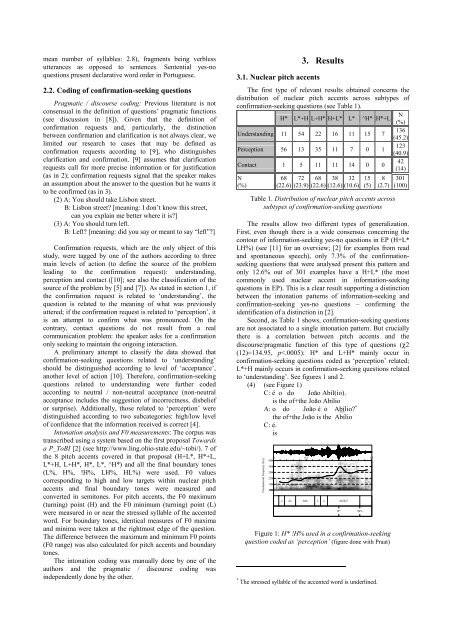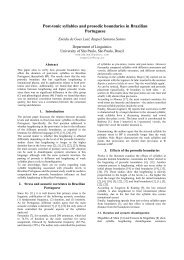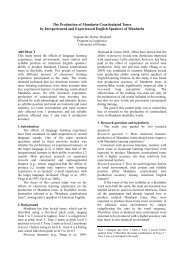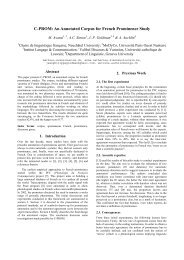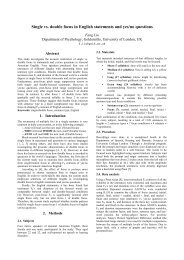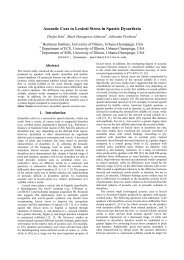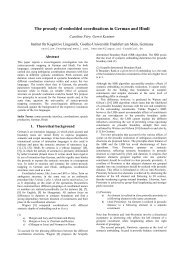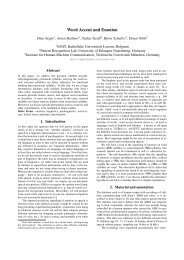On the Intonation of Confirmation-Seeking Requests in - Speech ...
On the Intonation of Confirmation-Seeking Requests in - Speech ...
On the Intonation of Confirmation-Seeking Requests in - Speech ...
You also want an ePaper? Increase the reach of your titles
YUMPU automatically turns print PDFs into web optimized ePapers that Google loves.
mean number <strong>of</strong> syllables: 2.8), fragments be<strong>in</strong>g verbless<br />
utterances as opposed to sentences. Sentential yes-no<br />
questions present declarative word order <strong>in</strong> Portuguese.<br />
2.2. Cod<strong>in</strong>g <strong>of</strong> confirmation-seek<strong>in</strong>g questions<br />
Pragmatic / discourse cod<strong>in</strong>g: Previous literature is not<br />
consensual <strong>in</strong> <strong>the</strong> def<strong>in</strong>ition <strong>of</strong> questions’ pragmatic functions<br />
(see discussion <strong>in</strong> [8]). Given that <strong>the</strong> def<strong>in</strong>ition <strong>of</strong><br />
confirmation requests and, particularly, <strong>the</strong> dist<strong>in</strong>ction<br />
between confirmation and clarification is not always clear, we<br />
limited our research to cases that may be def<strong>in</strong>ed as<br />
confirmation requests accord<strong>in</strong>g to [9], who dist<strong>in</strong>guishes<br />
clarification and confirmation. [9] assumes that clarification<br />
requests call for more precise <strong>in</strong>formation or for justification<br />
(as <strong>in</strong> 2); confirmation requests signal that <strong>the</strong> speaker makes<br />
an assumption about <strong>the</strong> answer to <strong>the</strong> question but he wants it<br />
to be confirmed (as <strong>in</strong> 3).<br />
(2) A: You should take Lisbon street.<br />
B: Lisbon street? [mean<strong>in</strong>g: I don’t know this street,<br />
can you expla<strong>in</strong> me better where it is?]<br />
(3) A: You should turn left.<br />
B: Left? [mean<strong>in</strong>g: did you say or meant to say “left”?]<br />
<strong>Confirmation</strong> requests, which are <strong>the</strong> only object <strong>of</strong> this<br />
study, were tagged by one <strong>of</strong> <strong>the</strong> authors accord<strong>in</strong>g to three<br />
ma<strong>in</strong> levels <strong>of</strong> action (to def<strong>in</strong>e <strong>the</strong> source <strong>of</strong> <strong>the</strong> problem<br />
lead<strong>in</strong>g to <strong>the</strong> confirmation request): understand<strong>in</strong>g,<br />
perception and contact ([10]; see also <strong>the</strong> classification <strong>of</strong> <strong>the</strong><br />
source <strong>of</strong> <strong>the</strong> problem by [5] and [7]). As stated <strong>in</strong> section 1, if<br />
<strong>the</strong> confirmation request is related to ‘understand<strong>in</strong>g’, <strong>the</strong><br />
question is related to <strong>the</strong> mean<strong>in</strong>g <strong>of</strong> what was previously<br />
uttered; if <strong>the</strong> confirmation request is related to ‘perception’, it<br />
is an attempt to confirm what was pronounced. <strong>On</strong> <strong>the</strong><br />
contrary, contact questions do not result from a real<br />
communication problem: <strong>the</strong> speaker asks for a confirmation<br />
only seek<strong>in</strong>g to ma<strong>in</strong>ta<strong>in</strong> <strong>the</strong> ongo<strong>in</strong>g <strong>in</strong>teraction.<br />
A prelim<strong>in</strong>ary attempt to classify <strong>the</strong> data showed that<br />
confirmation-seek<strong>in</strong>g questions related to ‘understand<strong>in</strong>g’<br />
should be dist<strong>in</strong>guished accord<strong>in</strong>g to level <strong>of</strong> ‘acceptance’,<br />
ano<strong>the</strong>r level <strong>of</strong> action [10]. Therefore, confirmation-seek<strong>in</strong>g<br />
questions related to understand<strong>in</strong>g were fur<strong>the</strong>r coded<br />
accord<strong>in</strong>g to neutral / non-neutral acceptance (non-neutral<br />
acceptance <strong>in</strong>cludes <strong>the</strong> suggestion <strong>of</strong> <strong>in</strong>correctness, disbelief<br />
or surprise). Additionally, those related to ‘perception’ were<br />
dist<strong>in</strong>guished accord<strong>in</strong>g to two subcategories: high/low level<br />
<strong>of</strong> confidence that <strong>the</strong> <strong>in</strong>formation received is correct [4].<br />
<strong>Intonation</strong> analysis and F0 measurements: The corpus was<br />
transcribed us<strong>in</strong>g a system based on <strong>the</strong> first proposal Towards<br />
a P_ToBI [2] (see http://www.l<strong>in</strong>g.ohio-state.edu/~tobi/). 7 <strong>of</strong><br />
<strong>the</strong> 8 pitch accents covered <strong>in</strong> that proposal (H+L*, H*+L,<br />
L*+H, L+H*, H*, L*, ^H*) and all <strong>the</strong> f<strong>in</strong>al boundary tones<br />
(L%, H%, !H%, LH%, HL%) were used. F0 values<br />
correspond<strong>in</strong>g to high and low targets with<strong>in</strong> nuclear pitch<br />
accents and f<strong>in</strong>al boundary tones were measured and<br />
converted <strong>in</strong> semitones. For pitch accents, <strong>the</strong> F0 maximum<br />
(turn<strong>in</strong>g) po<strong>in</strong>t (H) and <strong>the</strong> F0 m<strong>in</strong>imum (turn<strong>in</strong>g) po<strong>in</strong>t (L)<br />
were measured <strong>in</strong> or near <strong>the</strong> stressed syllable <strong>of</strong> <strong>the</strong> accented<br />
word. For boundary tones, identical measures <strong>of</strong> F0 maxima<br />
and m<strong>in</strong>ima were taken at <strong>the</strong> rightmost edge <strong>of</strong> <strong>the</strong> question.<br />
The difference between <strong>the</strong> maximum and m<strong>in</strong>imum F0 po<strong>in</strong>ts<br />
(F0 range) was also calculated for pitch accents and boundary<br />
tones.<br />
The <strong>in</strong>tonation cod<strong>in</strong>g was manually done by one <strong>of</strong> <strong>the</strong><br />
authors and <strong>the</strong> pragmatic / discourse cod<strong>in</strong>g was<br />
<strong>in</strong>dependently done by <strong>the</strong> o<strong>the</strong>r.<br />
3.1. Nuclear pitch accents<br />
3. Results<br />
The first type <strong>of</strong> relevant results obta<strong>in</strong>ed concerns <strong>the</strong><br />
distribution <strong>of</strong> nuclear pitch accents across subtypes <strong>of</strong><br />
confirmation-seek<strong>in</strong>g questions (see Table 1).<br />
H* L*+H L+H* H+L* L* ^H* H*+L N<br />
(%)<br />
Understand<strong>in</strong>g 11 54 22 16 11 15 7<br />
136<br />
(45.2)<br />
Perception 56 13 35 11 7 0 1<br />
123<br />
(40.9)<br />
Contact 1 5 11 11 14 0 0<br />
42<br />
(14)<br />
N<br />
(%)<br />
68 72 68 38 32<br />
(22.6) (23.9) (22.6) (12.6) (10.6)<br />
15<br />
(5)<br />
8<br />
(2.7)<br />
Table 1. Distribution <strong>of</strong> nuclear pitch accents across<br />
subtypes <strong>of</strong> confirmation-seek<strong>in</strong>g questions<br />
301<br />
(100)<br />
The results allow two different types <strong>of</strong> generalization.<br />
First, even though <strong>the</strong>re is a wide consensus concern<strong>in</strong>g <strong>the</strong><br />
contour <strong>of</strong> <strong>in</strong>formation-seek<strong>in</strong>g yes-no questions <strong>in</strong> EP (H+L*<br />
LH%) (see [11] for an overview; [2] for examples from read<br />
and spontaneous speech), only 7.3% <strong>of</strong> <strong>the</strong> confirmationseek<strong>in</strong>g<br />
questions that were analysed present this pattern and<br />
only 12.6% out <strong>of</strong> 301 examples have a H+L* (<strong>the</strong> most<br />
commonly used nuclear accent <strong>in</strong> <strong>in</strong>formation-seek<strong>in</strong>g<br />
questions <strong>in</strong> EP). This is a clear result support<strong>in</strong>g a dist<strong>in</strong>ction<br />
between <strong>the</strong> <strong>in</strong>tonation patterns <strong>of</strong> <strong>in</strong>formation-seek<strong>in</strong>g and<br />
confirmation-seek<strong>in</strong>g yes-no questions – confirm<strong>in</strong>g <strong>the</strong><br />
identification <strong>of</strong> a dist<strong>in</strong>ction <strong>in</strong> [2].<br />
Second, as Table 1 shows, confirmation-seek<strong>in</strong>g questions<br />
are not associated to a s<strong>in</strong>gle <strong>in</strong>tonation pattern. But crucially<br />
<strong>the</strong>re is a correlation between pitch accents and <strong>the</strong><br />
discourse/pragmatic function <strong>of</strong> this type <strong>of</strong> questions (χ2<br />
(12)=134.95, p


